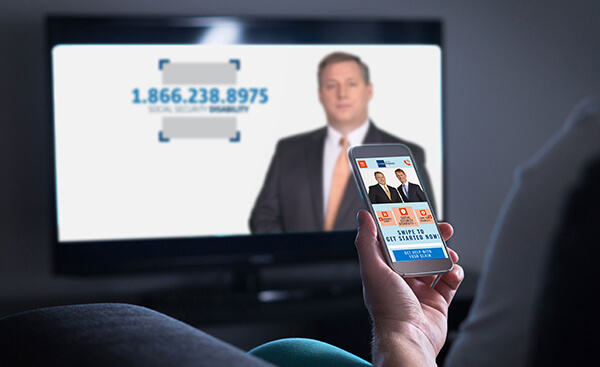Reach More Legal Clients with “Second-Screen Advertising”

Remember the phone book? When it was essential?
Every local lawyer needed a listing there. If a potential client saw your law firm’s commercial on TV, they’d flip to your ad in the phone book, confirm you’re the lawyer they wanted, and call.
What replaced that thick sheaf of paper on our desks? The slim screens in our pockets.
So as part of your law firm marketing, you need your “second-screen marketing” to be strong.
These days, TV advertising is still king, especially for lawyers. But now people watch TV with that second screen in hand. They Google for more information about what they’re watching (instead of cracking open the phone book).
This is the moment when you want your law firm website or online ads to seamlessly pick up where your TV commercial left off.
At our legal marketing agency, we often find that attorneys leave gaps in the path new clients take from one screen to another. Fix that, and you can accelerate your firm’s new case intakes and revenue.
Potent second-screen advertising means coordinating your law firm TV advertising, website search engine optimization (SEO) and Paid Search advertising.
Keep reading to find out how to factor second-screen marketing into your law firm advertising strategy. We’ll cover:
- Understanding the link between TV and mobile devices
- Creating marketing that’s crisp and consistent from one screen to the next
- Making sure your mobile website speed is robust
To Step Up Your Second-Screen Marketing, Look at Your Clients’ Screen Habits
Mandy Lee, media manager for Firmidable, says you can see the trend of people using multiple screens simultaneously in law firms’ marketing results.
“We have plenty of data showing people still call the number that shows up on your TV ad,” Mandy said. “But we also have data showing that they’re going to the website, too. The tipping point—where people are searching more on their mobile phones and not looking at your TV ad alone—has definitely happened.”
Google has done significant research on the topic, too. Their study found that 84 percent of smartphone and tablet owners use their “second screen” while watching television.
Furthermore, in 2015, while the Academy Awards aired, Google studied the rate of search queries related to the award winners and found a spike. They then displayed real-time advertisements congratulating each winner.
Linking the online ads to the TV audience led to a 19 percent increase in people clicking on the content from Google compared to other ads without the TV tie-in.
Here’s more from the study:
“Two-thirds of smartphone owners say they turn to their phones to learn more about something they saw in a TV commercial. An effective TV ad can stimulate dozens of micro-moments, where your potential customer is looking for more: product specs, prices, details, or reviews. These mobile moments are great opportunities for brands to provide an engaging experience.”
So, your TV ad—while still extremely valuable in today’s media landscape—doesn’t reach its full power in isolation. In fact, according to another study, 81 percent of people who use their cell phones or tablets while watching TV are researching what they’re seeing. And 65 percent of them look up items from advertisements specifically.
“When you look at your client intake numbers, pay attention to how many new clients are searching for you online and finding you when your TV ads are running, compared to when they’re not,” Mandy said. “The majority of the time there’s a big difference when you’re airing ads every week.”
RELATED
Make Your Law Firm Marketing Pieces Work Together—and Better
Make Sure Your Second-Screen Advertising Matches the First Screen
Now how do you make the two forms of media work together?
At our legal marketing firm, we emphasize the importance of integrated marketing. You need a smooth transition between screens (and any other forms of marketing you use), so users are confident they’re on the right path.
That means you have to match the language, the message, the tone, the colors, the design and multiple other pieces of your TV campaign and your digital marketing.
As Google itself said, “Make it easy for consumers when they reach out to learn more. Align your ad copy and landing page with your television creative.”
That is the essence of second-screen advertising.
“Everything needs to be integrated,” Mandy said. “We’ll see clients who have a different marketing firm doing their TV and their website, and it can lead to inconsistencies. That’s the last thing you want.”
When Potential Clients Get to the Second Screen, Don’t Keep Them Waiting
Talk to any SEO marketer today, and one of the first things they’ll mention is site speed.
It can be a huge ranking factor in internet search results. And it can be the difference between someone connecting to you on that second screen—or hitting the back button and finding your competitor.
Again, take Google’s word for it. In a 2019 study, here’s what they found:
“Fifty-four percent of people say that as the load time for a brand’s mobile site increases, so does their frustration. And that affects the bottom line. In retail, we’ve seen that a one-second delay in mobile load times can impact conversion rates by up to 20%.”
It takes a thorough tune-up of your site to improve the speed. You’ll need an audit of your site’s code, image sizes, interactive features and more.
Fine-tuning these little details can make a large difference in the cases your firm is snagging.
If you need help getting your second-screen marketing up to speed, talk to Firmidable today.
Firmidable has been a national expert in legal marketing for over 30 years. It brings law firms customized, data-driven marketing strategies and services, including online and traditional media for a wide range of legal practices. From Maine to Hawaii, it has transformed the lives of attorneys—and their clients.

